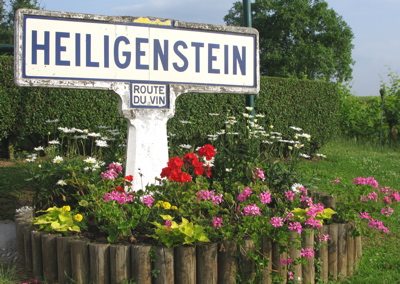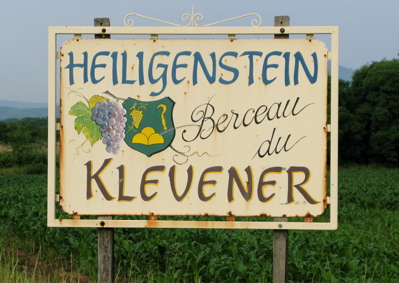
Klevener de Heiligenstein
Not very well known
Klevener de Heiligenstein grown on only 100 ha in Alsace. The cultivation is limited to the village Heiligenstein and to the neighboring villages of Bourgheim, Gertwiller, Goxwiller, and Obernai.
 The very variety is identical to Savagnin-rose mainly grown in the Jura, for example at the legendary Château Chalon. In Germany and Italy it is called Traminer grape, not to confuse with Gewurztraminer. In Alsace, the grape is also called Rotedel or Edelrose. Klevener de Heiligenstein became recognized as one of the 7 "noble" grapes in Alsace in June 1971.
The very variety is identical to Savagnin-rose mainly grown in the Jura, for example at the legendary Château Chalon. In Germany and Italy it is called Traminer grape, not to confuse with Gewurztraminer. In Alsace, the grape is also called Rotedel or Edelrose. Klevener de Heiligenstein became recognized as one of the 7 "noble" grapes in Alsace in June 1971.
The name Klevener is a little confusing because Klevner (or Clevner) is an approved name for Pinot Blanc. But Pinot Blanc is in turn defined as a white wine made from Auxerrois, Pinot Blanc, Pinot Gris and / or Pinot Noir. Got it?
The land where the wine can be grown are thin and highly situated at between 200 and 300 meters in altitude. The terroir comprises a mixture of pebbles, sand and clay relatively poor in lime. This limits the yield, which makes the wine vigorous and concentrated.
An exciting story
In the year 1742 was Ehrhard Wantz mayor of Heiligenstein, a village founded in the 9 th century and mentioned in 1181. Ehrhard Wantz made an inquiry to Le conseil des Echevins de Strasbourg to get the cultivation of Klevener sanctioned. The state initially provided permission for a lieu-dit called Au, but it was extended in 1753 to a larger area called Auboden. It is unclear whether the cultivation of Klevener de Heiligenstein was widespread even before 1742, but given that the wine caught twice the average price at the time, it is likely that the quality already been established and was high.
Different styles and taste
Klevener de Heiligenstein gives concentrated wines with a relatively strong taste. The aroma is like a attenuated style of Gewurztraminer. The taste is rich with good acidity and a clear and an idiosyncratic bitterness in the finish. Must weights may be high, especially in wine from old vines, and it is not uncommon to find a little residual sweetness. As exceptions, the wine may be directly sweet, like a vendanges tardives, especially in years with botrytis.
The wine benefits from a few years of cellaring, but should normally be drunk within 4-5 years. Thereafter, the acidity can be seen as muted relative to the wine's body.
Many producers
The total cropped area is about 100 hectares, and the total number of producers amounts to (at least) twenty. Many of the producers are very small and can be found in one of the five villages where the grape may be grown. In Heiligenstein, among others are Heywang, Daniel Ruff and Boch, of which the latter makes three cuvées. In Gertwiller one finds Habsinger and Zeyssolf.
 There are also producers in other villages, mainly in the communes of Barr and Mittelbergheim, both of which are located south of the growing area. In Barr is Charles Wantz, Klipfel, and the very interesting Vincent Stoeffler (Although Stoefflers Klevener de Heiligenstein may be to the sweet side, but he makes fantastic Riesling from the Riquewihr sector!), In Mittelbergheim, Rieffel and Rietsch are sure bets. Also, CV Andlau makes a nice Klevener de Heiligenstein.
There are also producers in other villages, mainly in the communes of Barr and Mittelbergheim, both of which are located south of the growing area. In Barr is Charles Wantz, Klipfel, and the very interesting Vincent Stoeffler (Although Stoefflers Klevener de Heiligenstein may be to the sweet side, but he makes fantastic Riesling from the Riquewihr sector!), In Mittelbergheim, Rieffel and Rietsch are sure bets. Also, CV Andlau makes a nice Klevener de Heiligenstein.
Must weight gram/L |
Potential alcohol % |
|
| AOC Alsace | 144 | 8.5% |